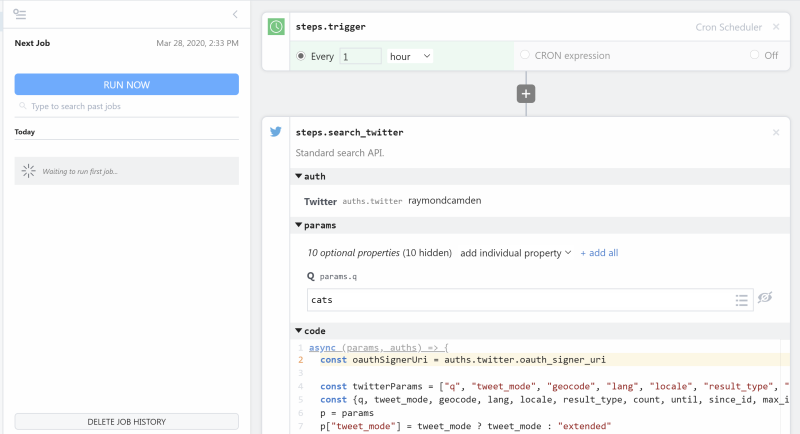What do you want to automate
with Google Cloud Document AI and HTTP / Webhook?
Prompt, edit and deploy AI agents that connect to Google Cloud Document AI, HTTP / Webhook and 3,000+ other apps in seconds.
Trusted by 1,000,000+ developers from startups to Fortune 500 companies
Popular Google Cloud Document AI and HTTP / Webhook Triggers#
Get a URL and emit the full HTTP event on every request (including headers and query parameters). You can also configure the HTTP response code, body, and more.
Get a URL and emit the HTTP body as an event on every request
Emit new event when the content of the URL changes.
Popular Google Cloud Document AI and HTTP / Webhook Actions#
Send an HTTP request using any method and URL. Optionally configure query string parameters, headers, and basic auth.
Send an HTTP GET request to any URL. Optionally configure query string parameters, headers and basic auth.
Send an HTTP POST request to any URL. Optionally configure query string parameters, headers and basic auth.
Send an HTTP PUT request to any URL. Optionally configure query string parameters, headers and basic auth.
Use with an HTTP trigger that uses "Return a custom response from your workflow" as its HTTP Response
Connect Google Cloud Document AI#
import { DocumentProcessorServiceClient } from '@google-cloud/documentai/build/src/v1/index.js';
import { promises as fs } from 'fs';
import { get } from 'https';
import { writeFile } from 'fs/promises';
import { join } from 'path';
export default defineComponent({
props: {
google_cloud_document_ai: {
type: "app",
app: "google_cloud_document_ai",
}
},
async run({ steps, $ }) {
//Sample pdf file to process by Google Document AI API
const url = 'https://www.learningcontainer.com/wp-content/uploads/2019/09/sample-pdf-file.pdf';
const filePath = join('/tmp', 'my_document.pdf');
const downloadFile = async () => {
const res = await new Promise((resolve) => get(url, resolve));
const chunks = [];
for await (const chunk of res) {
chunks.push(chunk);
}
await writeFile(filePath, Buffer.concat(chunks));
console.log(`File downloaded successfully to ${filePath}`);
};
await downloadFile();
const projectId = this.google_cloud_document_ai.$auth.project_id;
const location = this.google_cloud_document_ai.$auth.location;
const processorId = this.google_cloud_document_ai.$auth.processor_id;
// Instantiates a client
// apiEndpoint regions available: eu-documentai.googleapis.com, us-documentai.googleapis.com (Required if using eu based processor)
// const client = new DocumentProcessorServiceClient({apiEndpoint: 'eu-documentai.googleapis.com'});
const client = new DocumentProcessorServiceClient();
async function testRequest() {
// The full resource name of the processor, e.g.:
// projects/project-id/locations/location/processor/processor-id
// You must create new processors in the Cloud Console first
const name = `projects/${projectId}/locations/${location}/processors/${processorId}`;
// Read the file into memory.
const imageFile = await fs.readFile(filePath);
// Convert the image data to a Buffer and base64 encode it.
const encodedImage = Buffer.from(imageFile).toString('base64');
const request = {
name,
rawDocument: {
content: encodedImage,
mimeType: 'application/pdf',
},
};
// Recognizes text entities in the PDF document
const [result] = await client.processDocument(request);
const { document } = result;
// Get all of the document text as one big string
const { text } = document;
// Extract shards from the text field
const getText = textAnchor => {
if (!textAnchor.textSegments || textAnchor.textSegments.length === 0) {
return '';
}
// First shard in document doesn't have startIndex property
const startIndex = textAnchor.textSegments[0].startIndex || 0;
const endIndex = textAnchor.textSegments[0].endIndex;
return text.substring(startIndex, endIndex);
};
// Read the text recognition output from the processor
const [page1] = document.pages;
const { paragraphs } = page1;
let concatenatedText = "";
for (const paragraph of paragraphs) {
const paragraphText = getText(paragraph.layout.textAnchor);
concatenatedText += paragraphText;
}
return concatenatedText;
}
return await testRequest();
}
})Overview of HTTP / Webhook#
Build, test, and send HTTP requests without code using your Pipedream workflows. The HTTP / Webhook action is a tool to build HTTP requests with a Postman-like graphical interface.

Point and click HTTP requests
Define the target URL, HTTP verb, headers, query parameters, and payload body without writing custom code.

Focus on integrating, not authenticating
This action can also use your connected accounts with third-party APIs. Selecting an integrated app will automatically update the request’s headers to authenticate with the app properly, and even inject your token dynamically.

Pipedream integrates with thousands of APIs, but if you can’t find a Pipedream integration simply use Environment Variables in your request headers to authenticate with.
Compatible with no code actions or Node.js and Python
The HTTP/Webhook action exports HTTP response data for use in subsequent workflow steps, enabling easy data transformation, further API calls, database storage, and more.
Response data is available for both coded (Node.js, Python) and no-code steps within your workflow.

Connect HTTP / Webhook#
// To use any npm package on Pipedream, just import it
import axios from "axios"
export default defineComponent({
async run({ steps, $ }) {
const { data } = await axios({
method: "GET",
url: "https://pokeapi.co/api/v2/pokemon/charizard",
})
return data.species
},
})
Community Posts#

